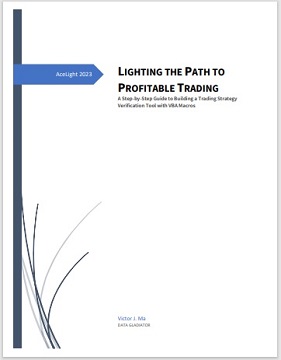Bulls, Bears, and Beginners: A Guide to Stock Trading Strategies and Tips
|
|
Are you tired of watching your money sit idly in a savings account, earning
a measly interest rate? Do you dream of living the high life, complete with
a yacht, a private jet, and a pet tiger? Well, I hate to break it to you,
but the last one might not be possible. However, if you're willing to take a
risk and try your luck in the stock market, you might just be able to
achieve your other goals. Of course, if you're new to stock trading, you
might feel like a deer in headlights, unsure of what to do next. But fear
not, in this post, I'll be sharing some beginner stock trading strategies
and tips that will help you navigate the market with confidence and, who
knows, maybe even make a few bucks along the way.
1. Do Your Research
Before you start trading, it is essential to
do your research. Researching the stocks you plan to invest in can help you
make informed decisions. You should always keep an eye on the news and any
upcoming events that may impact the stock's performance.
For example,
let's say you plan to invest in a tech company like Apple. You should
research the company's financials, such as their revenue and earnings
growth. You should also keep an eye on any upcoming product releases or
events that may impact the company's stock price.
2. Have a Strategy
Having a strategy is crucial when it comes to stock trading. Your
strategy should be based on your financial goals and risk tolerance. There
are several trading strategies you can use, such as swing trading, day
trading, and value investing.
For example, if you are a beginner, you
may want to start with value investing. Value investing involves looking for
undervalued stocks and holding them for the long term. This strategy
requires patience and discipline, but it can be a great way to generate
consistent returns.
3. Diversify Your Portfolio
Diversifying
your portfolio is another important strategy for beginner stock traders.
Diversification helps to spread your risk and reduces the impact of market
volatility on your portfolio.
For example, instead of investing all
your money in one stock, you can invest in multiple stocks from different
sectors. You can also invest in mutual funds or exchange-traded funds
(ETFs), which provide diversification by holding a basket of stocks.
4. Use Stop Loss Orders
Stop loss orders are another essential tool
for beginner stock traders. A stop loss order is an order to sell a stock
when it reaches a certain price. This helps to limit your losses if the
stock's price drops.
For example, let's say you bought a stock at $50
per share. You can set a stop loss order at $45 per share, which means if
the stock's price drops to $45 or lower, your shares will be sold
automatically.
5. Be Patient
Patience is key when it comes to
stock trading. You should not expect to make a fortune overnight. It takes
time to build a successful portfolio and generate consistent returns.
For example, let's say you invested in a stock that you believe has
great potential. However, the stock's price has been volatile, and you have
not seen any significant gains. Instead of selling the stock, you should be
patient and hold it for the long term. Over time, the stock may perform well
and generate significant returns.
6. Learn from Your Mistakes
Mistakes are a natural part of stock trading. However, it is essential
to learn from your mistakes and not repeat them in the future.
For
example, let's say you invested in a stock based on a rumor you heard. The
stock's price dropped, and you lost a significant amount of money. Instead
of blaming others, you should take responsibility for your mistake and learn
from it. In the future, you should rely on research and analysis rather than
rumors and hearsay.
7. Have Realistic Expectations
Finally,
it is essential to have realistic expectations when it comes to stock
trading. You should not expect to make a fortune overnight or become a
millionaire in a year.
For example, let's say you invested $1,000 in
a stock. If the stock's price increases by 10%, you would have made a profit
of $100. While this may not seem like a lot of money, it is still a
significant return on your investment. Over time, with consistent returns,
your portfolio will grow, and you can achieve your financial goals.
8. Back Testing
Back testing is the process of testing a trading
strategy using historical data to see how it would have performed in the
past. It is a valuable tool for beginner traders to evaluate the performance
of their strategy and identify potential flaws.
For example, let's
say you have a swing trading strategy that involves buying stocks based on
technical analysis. You can use historical data to test your strategy and
see how it would have performed over a specific period. If the strategy
performed well in the past, it may have a higher probability of success in
the future.
9. Forward Testing
Forward testing is the process
of testing a trading strategy using real-time data to see how it performs in
the current market conditions. It is a valuable tool for beginner traders to
evaluate the performance of their strategy in real-world situations.
For example, let's say you have a day trading strategy that involves buying
and selling stocks based on news and market events. You can forward test
your strategy by paper trading or using a small amount of capital to see how
it performs in real-time. If the strategy performs well in the current
market conditions, you can consider using it with larger capital and taking
real trades.
 No
matter how perfect a trading strategy works in theory, we need to test it
before we really use it in the market. These tests include back-testing and
forward-testing. The same one stock trading strategy works for different
stock and uses different parameters, there will be hundreds or even
thousands of different results. We need some methods and tools to verify
which trading strategy works well for which stock, and under what
conditions. Our tutorial handbook is offering some methods and tools to
execute these testing and verifying tasks. You can download it for free,
click here:
LIGHTING THE PATH TO PROFITABLE TRADING: A Step-by-Step Guide to Building a
Trading Strategy Verification Tool with VBA Macros No
matter how perfect a trading strategy works in theory, we need to test it
before we really use it in the market. These tests include back-testing and
forward-testing. The same one stock trading strategy works for different
stock and uses different parameters, there will be hundreds or even
thousands of different results. We need some methods and tools to verify
which trading strategy works well for which stock, and under what
conditions. Our tutorial handbook is offering some methods and tools to
execute these testing and verifying tasks. You can download it for free,
click here:
LIGHTING THE PATH TO PROFITABLE TRADING: A Step-by-Step Guide to Building a
Trading Strategy Verification Tool with VBA Macros
And click Free
Trial to download strategies testing tools, all for a 30-day Free Trial.
Click on Subscription to order more strategies testing tools to help your stock trading.
When it comes to trading strategies, there are several
options that beginner traders can consider. Here are a few strategies that
are typically recommended for beginners:
1. Buy and Hold Strategy:
The buy and hold strategy is an investment strategy that involves buying a
stock and holding onto it for a long time. This strategy is suitable for
beginner traders who want to invest in stable, well-established companies
that are likely to grow over time. The key to this strategy is to select a
diversified portfolio of stocks and hold onto them for an extended period,
ignoring short-term market fluctuations.
2. Dollar-Cost Averaging:
Dollar-cost averaging is an investment strategy that involves investing a
fixed amount of money in a stock at regular intervals, regardless of the
stock's price. This strategy is suitable for beginner traders who want to
invest in the stock market regularly but are concerned about market
volatility. By investing a fixed amount of money at regular intervals,
traders can avoid the risk of investing a large sum of money at the wrong
time.
3. Swing Trading: Swing trading is a trading strategy that
involves buying and holding stocks for a short period, typically a few days
to a few weeks. This strategy is suitable for beginner traders who want to
take advantage of short-term price movements in the market. Swing traders
use technical analysis to identify stocks with strong momentum and then buy
and hold them until they reach a predetermined target price.
4.
Growth Investing: Growth investing is a strategy that involves investing in
stocks with high growth potential. This strategy is suitable for beginner
traders who want to invest in companies that are likely to grow rapidly in
the future. Growth investors typically look for companies with strong
earnings growth, high revenue growth, and innovative products or services.
Remember, trading stocks can be a rollercoaster ride, with ups and
downs, twists and turns, and unexpected surprises. But with a solid
strategy, a diversified portfolio, and a bit of luck, you can come out on
top. And who knows, maybe one day you'll be sipping champagne on your own
yacht, surrounded by your pet tiger and your private jet parked nearby. Just
don't forget to invite me to the party! Until then, happy trading!
|


|

Free Tutorial
Share
|
|
|
|